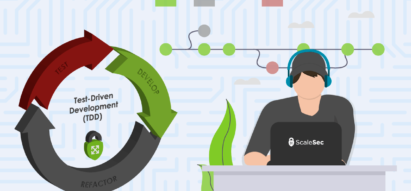Have you ever struggled to make a simple change to some dense, hard-to-understand code? Or have you ever tried to add a new feature to a tangled, interdependent codebase, only to get lost in a mess? If so, you know the frustration of code complexity.
But code complexity is more than just a nuisance – it’s a severe problem that can have real consequences for your organization. When complex code is more challenging to understand, test, and maintain, which can lead to decreased developer productivity, code quality, and customer satisfaction. And all of these things can cost your organization time and money.
But you don’t have to let code complexity hold you back. By measuring and reducing cyclomatic and cognitive complexity, you can improve your code’s quality, maintainability, and reliability. You can increase your team’s productivity, reduce the risk of errors and bugs, and deliver better software to your customers. Take control of your code complexity today – learn how to measure and mitigate cyclomatic and cognitive complexity. Let’s get into more details:
First, let’s understand what Cyclomatic Complexity is.
Cyclomatic complexity is a measure of the complexity of a computer program. It is a quantitative measure of the number of linearly independent paths through a program’s source code.
In general, programs with high cyclomatic complexity are more difficult to understand, test, and maintain than those with lower complexity. It is because programs with high complexity have a more significant number of paths through their source code which leads to more behaviors, making it more difficult to understand them and identify and fix any errors or bugs in the program.
Now let’s take a look at Cognitive Complexity:
Cognitive complexity measures the difficulty of understanding or comprehending a concept or idea. It is often used in education to assess the difficulty of learning materials or tasks and to design educational programs or materials appropriate for different learner abilities.
Cognitive complexity can be influenced by various factors, including the level of abstraction of the concept or idea being learned, prior knowledge or familiarity with it, and multiple interacting components.
What’s the importance of measuring cyclomatic and cognitive complexities:
It can be essential to measure the cyclomatic and cognitive complexity of code in software engineering, as these measures can provide valuable insights into the quality and maintainability of a program.
Programs with high cyclomatic complexity may be more prone to errors or bugs and more challenging to maintain over time.
On the other hand, cognitively complex code may be more difficult for developers to understand and may be more prone to errors or bugs.
Measuring cyclomatic and cognitive complexity and dealing with them can help developers identify areas of the code that may need to be simplified or refactored and help them make informed decisions about designing and maintaining their programs. However, it is essential to note that these measures are only one aspect of code quality and should be considered in conjunction with other factors, such as code readability, maintainability, and performance.
Advantages of measuring and dealing with cyclomatic and cognitive complexity:
There are several benefits of measuring and dealing with the cyclomatic complexity and cognitive complexity of code in software engineering, which include but are not limited to the following:
- Improved code quality: Code with low cyclomatic complexity and cognitive complexity is generally easier to understand, test, and maintain than code with high complexity. By measuring and monitoring the complexity of your code, you can identify areas of the code that may need to be simplified or refactored to improve its quality.
- Increased developer productivity: Code that is easy to understand and work with can help developers be more productive, as they can more easily understand and modify the code as needed. By measuring and reducing the complexity of your code, you can help your developers be more effective and efficient.
- Enhanced maintainability: Code that is easy to understand and modify is generally easier to maintain over time. By measuring and reducing the complexity of your code, you can make it more maintainable, which saves time and resources in the long run.
- Improved reliability: Code that is easy to understand and test is generally more reliable than complex code.
- By measuring and reducing the complexity of your code, you can help improve its reliability and reduce the risk of errors or bugs.
Now that we have learned what cyclomatic and cognitive code complexity is and the advantages of dealing with them, it would be great to look at some expert tips on dealing with these complexities.
Here are some tips from experts to deal with cyclomatic complexity:
- Refactor complex code: One way to reduce cyclomatic complexity is to refactor complex code into cleaner, more modular components. It can help make the code easier to understand and test and can help reduce the number of linearly independent paths through the code.
- Use control flow statements carefully: Control flow statements, such as if statements and for loops, can create multiple paths through the code and increase cyclomatic complexity. Using these statements carefully, and minimizing the use of nested control flow statements, can help reduce cyclomatic complexity.
- Avoid overly complex algorithms: Using complex algorithms or data structures can also increase cyclomatic complexity. Consider using simpler algorithms or data structures, breaking complex algorithms into smaller, more modular functions.
- Use functions and modules: Dividing your code into smaller parts and modules can reduce cyclomatic complexity, allowing you to break up complex code into more manageable chunks.
- Use comments and documentation: Adding comments and documentation to your code can help make it easier to understand, which can help reduce cognitive complexity. It can minimize cyclomatic complexity, making it easier to understand and test well-documented code.
And here are a few expert tips for reducing cognitive complexity in software engineering:
- Use explicit, descriptive variable and function names: Using descriptive names for variables and functions can help make your code easier to understand, which can help reduce cognitive complexity.
- Break up complex code into smaller, more modular functions: Dividing complex code into smaller, more modular parts can help make it easier to understand and work with, which can help reduce cognitive complexity.
- Use comments and documentation: Adding comments and documentation to your code can help make it easier to understand, which can help reduce cognitive complexity.
- Use design patterns: Design patterns are established solutions to common design problems that can help make your code more maintainable and easier to understand. Using design patterns can help reduce cognitive complexity.
- Use clear, consistent formatting: Using clear, consistent formatting, such as using whitespace and indentation consistently, can help make your code easier to read and understand, which can help reduce cognitive complexity.
As you can see, these complexities are correlated, and dealing with one part affects the other.
Now let’s take a look at how we can measure them:
As you may guess, measuring cognitive and cyclomatic complexity is not a human job. Also, as your code base grows, especially in monolith and modular monolith architecture, it would be impossible to measure these complexities by hand. The best practice here would be to measure these complexities using code analysis tools and integrate them into your continuous integration pipelines. Software engineers can integrate several tools into their CI pipelines to measure code’s cyclomatic and cognitive complexity. Some examples include:
SonarQube: This is a code analysis tool that can measure a wide range of code quality metrics, including cyclomatic complexity, cognitive complexity, and readability. It can be integrated into a CI pipeline using a variety of plugins and integrations.
Code Climate: This is a code analysis platform that can also measure various code quality metrics, including cyclomatic complexity, cognitive complexity, and maintainability. It can be integrated into a CI pipeline using a variety of plugins and integrations.
McCabe’s Cyclomatic Complexity Tool: This tool, developed by Thomas J. McCabe, Sr., can be used to calculate the cyclomatic complexity of a program. It can be run from the command line or integrated into a CI pipeline.
Halstead Metrics: This tool can calculate Halstead complexity measures, including program length, vocabulary size, difficulty, and volume. It can be run from the command line or integrated into a CI pipeline.
Many other tools can be used to measure cyclomatic and cognitive complexity, and the choice of tool will depend on your team’s specific needs and preferences.
However, there are a few things to consider when measuring and dealing with cyclomatic and cognitive complexity in software engineering:
- Cyclomatic complexity is a measure of the number of linearly independent paths through a program’s source code and is based on the code’s control flow. It is a helpful metric for identifying areas of the code that may be more complex or difficult to test, but it does not take into account other factors that can affect the cognitive complexity of the code, such as the level of abstraction or the use of comments and documentation.
- Cognitive complexity is a measure of the difficulty of understanding or comprehending a concept or idea and can be influenced by various factors, including the level of abstraction, the presence of multiple interacting components, and the level of prior knowledge or familiarity with the concept.
- Cyclomatic and Cognitive complexity is only one aspect of code quality and should be considered in conjunction with other factors, such as code readability, maintainability, and performance.
- Important: It is vital to use cyclomatic and cognitive complexity measures appropriately and to consider their limitations. These measures can provide valuable insights into the quality and maintainability of your code, but they should be used in collaboration with others and should not be the only factors considered when assessing the quality of your code.
Measuring and reducing your code’s cyclomatic and cognitive complexity can improve its quality, maintainability, and reliability and help your developers be more productive and effective.
I hope you enjoyed the article and it is of some value to you.
Till next time


Leave your comment